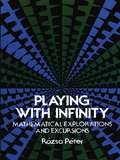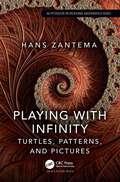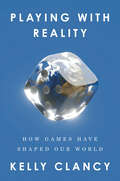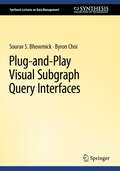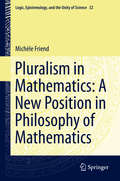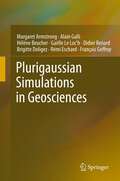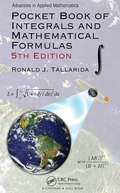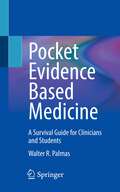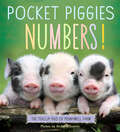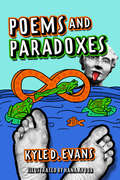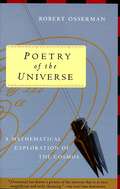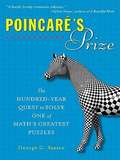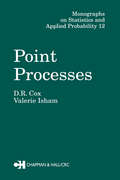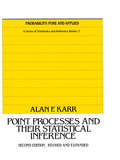- Table View
- List View
Playing with Infinity: Mathematical Explorations And Excursions (Dover Books on Mathematics)
by Rózsa PéterThis popular account of the many mathematical concepts relating to infinity is one of the best introductions to this subject and to the entire field of mathematics. Dividing her book into three parts -- The Sorcerer's Apprentice, The Creative Role of Form, and The Self-Critique of Pure Reason -- Peter develops her material in twenty-two chapters that sound almost too appealing to be true: playing with fingers, coloring the grey number series, we catch infinity again, the line is filled up, some workshop secrets, the building rocks, and so on.Yet, within this structure, the author discusses many important mathematical concepts with complete accuracy: number systems, arithmetical progression, diagonals of convex polygons, the theory of combinations, the law of prime numbers, equations, negative numbers, vectors, operations with fractions, infinite series, irrational numbers, Pythagoras' Theorem, logarithm tables, analytical geometry, the line at infinity, indefinite and definite integrals, the squaring of the circle, transcendental numbers, the theory of groups, the theory of sets, metamathematics, and much more. Numerous illustrations and examples make all the material readily comprehensible.Without being technical or superficial, the author writes with complete clarity and much originality on the whole range of topics from counting to mathematical logic. Using little algebra and no mathematical formulas, she has written an unusual book that will interest even mathematicians and teachers. Beginning mathematics students and people in the humanities and other fields will find the book particularly outstanding for their purposes.
Playing with Infinity: Turtles, Patterns, and Pictures (AK Peters/CRC Recreational Mathematics Series)
by Hans ZantemaThis is a book about infinity - specifically the infinity of numbers and sequences. Amazing properties arise, for instance, some kinds of infinity are argued to be greater than others. Along the way the author will demonstrate how infinity can be made to create beautiful ‘art’, guided by the development of underlying mathematics. This book will provide a fascinating read for anyone interested in number theory, infinity, math art, and/or generative art, and could be used a valuable supplement to any course on these topics.Features: Beautiful examples of generative art Accessible to anyone with a reasonable high school level of mathematics Full of challenges and puzzles to engage readers
Playing with Reality: How Games Have Shaped Our World
by Kelly ClancyA wide-ranging intellectual history that reveals how important games have been to human progress, and what&’s at stake when we forget what games we&’re really playing.We play games to learn about the world, to understand our minds and the minds of others, and to make predictions about the future. Games are an essential aspect of humanity and a powerful tool for modeling reality. They&’re also a lot of fun. But games can be dangerous, especially when we mistake the model worlds of games for reality itself and let gamification co-opt human decision making.Playing with Reality explores the riveting history of games since the Enlightenment, weaving an unexpected path through military theory, political science, evolutionary biology, the development of computers and AI, cutting-edge neuroscience, and cognitive psychology. Neuroscientist and physicist Kelly Clancy shows how intertwined games have been with the arc of history. War games shaped the outcomes of real wars in nineteenth and twentieth century Europe. Game theory warped our understanding of human behavior and brought us to the brink of annihilation—yet still underlies basic assumptions in economics, politics, and technology design. We used games to teach computers how to learn for themselves, and now we are designing games that will determine the shape of society and future of democracy.In this revelatory new work, Clancy makes the bold argument that the human fascination with games is the key to understanding our nature and our actions.
Plug-and-Play Visual Subgraph Query Interfaces (Synthesis Lectures on Data Management)
by Sourav S. Bhowmick Byron ChoiThis book details recent developments in the emerging area of plug-and-play (PnP) visual subgraph query interfaces (VQI). These PnP interfaces are grounded in the principles of human-computer interaction (HCI) and cognitive psychology to address long-standing limitations to bottom-up search capabilities in graph databases using traditional graph query languages, which often require domain experts and specialist programmers. This book explains how PnP interfaces go against the traditional mantra of VQI construction by taking a data-driven approach and giving end users the freedom to easily and quickly construct and maintain a VQI for any data sources without resorting to coding. The book walks readers through the intuitive PnP interface that uses templates where the underlying graph repository represents the socket and user-specified requirements represent the plug. Hence, a PnP interface enables an end user to change the socket (i.e., graph repository) or the plug (i.e., requirements) as necessary to automatically and effortlessly generate VQIs. The book argues that such a data-driven paradigm creates several benefits, including superior support for visual subgraph query construction, significant reduction in the manual cost of constructing and maintaining a VQI for any graph data source, and portability of the interface across diverse sources and querying applications. This book provides a comprehensive introduction to the notion of PnP interfaces, compares it to its classical manual counterpart, and reviews techniques for automatic construction and maintenance of these new interfaces. In synthesizing current research on plug-and-play visual subgraph query interface management, this book gives readers a snapshot of the state of the art in this topic as well as future research directions.
Pluralism in Mathematics: A New Position in Philosophy of Mathematics
by Michèle FriendThis book is about philosophy, mathematics and logic, giving a philosophical account of Pluralism which is a family of positions in the philosophy of mathematics. There are four parts to this book, beginning with a look at motivations for Pluralism by way of Realism, Maddy's Naturalism, Shapiro's Structuralism and Formalism. In the second part of this book the author covers: the philosophical presentation of Pluralism; using a formal theory of logic metaphorically; rigour and proof for the Pluralist; and mathematical fixtures. In the third part the author goes on to focus on the transcendental presentation of Pluralism, and in part four looks at applications of Pluralism, such as a Pluralist approach to proof in mathematics and how Pluralism works in regard to together-inconsistent philosophies of mathematics. The book finishes with suggestions for further Pluralist enquiry. In this work the author takes a deeply radical approach in developing a new position that will either convert readers, or act as a strong warning to treat the word 'pluralism' with care.
Plurigaussian Simulations in Geosciences
by Margaret Armstrong Brigitte Doligez Francois Geffroy Hélène Beucher Rémi Eschard Didier Renard Gaelle Loc'H Alain GalliSimulation is the fastest developing branch of geostatistics and simulating facies inside reservoirs and orebodies is the most exciting part of this. Several methods have been developed to do this (sequential indicator simulations, Boolean simulations, Markov chains and plurigaussian simulations). This book focuses on the last type of simulations. It presents the theory required to understand the method, along practical examples of applications in mining and the oil industry as well as tutorial exercises. Demonstration software to illustrate how these simulations work is available on http://pluridemo.geosciences.mines-paristech.fr Since the publication of the first edition, enormous numbers of papers have appeared in the literature on the subject. Plurigaussian simulations are now the preferred method for simulating facies in both mining & the oil industry. The new edition contains new case studies in both mining & petroleum, together with an extensively updated theory section.
Pluripotential Theory: Filippo Bracci, John Erik Fornæss
by John Erik Fornæss Francois Berteloot Jean Pierre Demailly Filippo Bracci Giorgio Patrizio Zbigniew BłockiPluripotential theory is a very powerful tool in geometry, complex analysis and dynamics. This volume brings together the lectures held at the 2011 CIME session on "pluripotential theory" in Cetraro, Italy. This CIME course focused on complex Monge-Ampére equations, applications of pluripotential theory to Kahler geometry and algebraic geometry and to holomorphic dynamics. The contributions provide an extensive description of the theory and its very recent developments, starting from basic introductory materials and concluding with open questions in current research.
Pluses and Minuses: How Math Solves Our Problems
by Stefan BuijsmanA guide to changing how you think about numbers and mathematics, from the prodigy changing the way the world thinks about math.We all know math is important: we live in the age of big data, our lives are increasingly governed by algorithms, and we're constantly faced with a barrage of statistics about everything from politics to our health. But what might be less obvious is how math factors into your daily life, and what memorizing all of those formulae in school had to do with it. Math prodigy Stefan Buijsman is beginning to change that through his pioneering research into the way we learn math. Plusses and Minuses is based in the countless ways that math is engrained in our daily lives, and shows readers how math can actually be used to make problems easier to solve. Taking readers on a journey around the world to visit societies that have developed without the use of math, and back into history to learn how and why various disciples of mathematics were invented, Buijsman shows the vital importance of math, and how a better understanding of mathematics will give us a better understanding of the world as a whole. Stefan Buijsman has become one of the most sought-after experts in math education after he completed his PhD at age 20. In Plusses and Minuses, he puts his research into practice to help anyone gain a better grasp of mathematics than they have ever had.
Pluses and Minuses: How Maths Makes the World More Manageable
by Stefan BuijsmanWhat is the relationship between the number of films Nicolas Cage appears in and the number of deaths by drowning in swimming pools?How in 1850s London did John Snow calculate the relationship between the city's water suppliers and the number of deaths from cholera?Thousands of years ago the inhabitants of Mesopotamia became the first to use numbers. Since then, mathematics has been unstoppable. It's behind almost everything, from search-engines to cruise-control, from coffee-makers to timetables. But now that we hardly ever need to do arithmetic any longer, how relevant is mathematics to everyday life? Plusses and Minuses demonstrates which role mathematics play in human endeavour. It begins with the mathematical skills we all possess from birth, to arrive at the many applications of mathematics today. It turns out that without knowledge of the ideas behind mathematical calculations we find ourselves sidelined. Stefan Buijsman answers questions such as: What is life without numbers? Does mathematics add anything? What are mistakes in mathematics? Is it all mere chance? How can we get a grip on uncertainty? Can mathematics help us to treat cancer more effectively? Buijsman makes connections between philosophy, psychology and history, while explaining the wonderful world of mathematics for absolutely everyone.
Pocket Book of Integrals and Mathematical Formulas
by Ronald J. TallaridaPocket Book of Integrals and Mathematical Formulas, 5th Edition covers topics ranging from precalculus to vector analysis and from Fourier series to statistics, presenting numerous worked examples to demonstrate the application of the formulas and methods. This popular pocket book is an essential source for students of calculus and higher mathemati
Pocket Evidence Based Medicine: A Survival Guide for Clinicians and Students
by Walter R. PalmasThis concise, easy-to-read pocket guide offers medical trainees, researchers, and clinicians at every level the perfect resource on Evidence Based Medicine (EBM). Based on the author’s many years of experience teaching EBM to medical students and medical residents at Columbia University, this handy title addresses not only all the basic concepts and issues in EBM, but also takes an example-based approach and is replete with numerous illustrations. This brief book provides readers with all the tools needed to tell the good from the bad in healthcare research. It discusses every type of study design, from the assessment of diagnostic tests to clinical trials and meta-analysis. The work also introduces readers to novel methods, such as the Bayesian analysis of clinical trials. In addition, to help readers better retain the information, the guide includes thought-provoking review questions and answers in an appendix. In all, Pocket Evidence-Based Medicine: A Survival Guide for Clinicians and Students is an ideal resource for anyone who encounters statistics in their studies or career, including clinicians, researchers, trainees in medicine and graduate students in a wide range of other disciplines
Pocket Piggies Numbers!: Featuring the Teacup Pigs of Pennywell Farm
by Richard AustinCould there be a cuter way to learn colors and numbers? Announcing a new line of board books featuring the irresistible Teacup Pigs of Pennywell Farm. Small enough to hold in the palm of your hand, the Pennywell pigs are an adorable lot. They’re also naturals in front of the camera—especially the camera belonging to Richard Austin who, as their exclusive photographer, knows just how to capture their big personalities. The Pocket Piggies board books marry the inherent appeal of Teacup Pigs to the sweetness of the board book format. The photographs are full-color, full-page, and up-close. The subjects are classics: Pocket Piggies Numbers! celebrates an ever-growing crowd of piggies, from one to ten, through a rhyming text that’s sweet and charming, to read again and again: <p>1 Pocket Piggy in a boat,<p> <p>2 Pocket Piggies in a cup,<p> <p>3 Pocket Piggies in a basket,<p> <p>4 Pocket Piggies with a pup!<p>
Poems and Paradoxes
by Hana Ayoob Kyle D. Evans17 Chapters of Paradoxes and Fascinating Ideas...a poems and pictures to help you remember them! How big is a billion? How much would you pay for a one coin? Why are no numbers boring? This collection answers these questions and many more, setting fun poetry and illustrations against fascinating mathematical ideas in a unique and amusing way. This book will appeal to math-hungry teens and young adults, but also to anyone who enjoys wordplay and mind-bending concepts. Teachers of students at various levels will find content that can be applied to lessons.
Poetic Logic and the Origins of the Mathematical Imagination (Mathematics in Mind)
by Marcel DanesiThis book treats eighteenth-century Italian philosopher Giambattista Vico’s theory of poetic logic for the first time as the originating force in mathematics, transforming instinctive counting and spatial perception into poetic (metaphorical) symbolism that dovetails with the origin of language. It looks at current work on mathematical cognition (from Lakoff and Núñez to Butterworth, Dehaene, and beyond), matching it against the poetic logic paradigm. In a sense, it continues from where Kasner and Newman left off, connecting contemporary research on the mathematical mind to the idea that the products of early mathematics were virtually identical to the first forms of poetic language. As such, this book informs the current research on mathematical cognition from a different angle, by looking back at a still relatively unknown philosopher within mathematics.The aim of this volume is to look broadly at what constitutes the mathematical mind through the Vichian lens of poetic logic. Vico was among the first to suggest that the essential nature of mind could be unraveled indirectly by reconstructing the sources of its “modifications” (his term for “creations”); that is, by examining the creation and function of symbols, words, and all the other uniquely human artifacts—including mathematics—the mind has allowed humans to establish “the world of civil society,” Vico’s term for culture and civilization.The book is of interest to cognitive scientists working on math cognition. It presents the theory of poetic logic as Vico articulated it in his book The New Science, examining its main premises and then applying it to an interpretation of the ongoing work in math cognition. It will also be of interest to the general public, since it presents a history of early mathematics through the lens of an idea that has borne fruit in understanding the origin of language and symbols more broadly.
Poetry of the Universe
by Robert OssermanAn exciting intellectual tour through the ages showing how mathematical concepts and imagination have helped to illuminate the nature of the observable universe, this book is a delightful narrative "math for poets."
Poincare's Prize: The Hundred-Year Quest to Solve One of Math's Greatest Puzzles
by George G. SzpiroThe amazing story of one of the greatest math problems of all time and the reclusive genius who solved itIn the tradition of Fermat's Enigma and Prime Obsession, George Szpiro brings to life the giants of mathematics who struggled to prove a theorem for a century and the mysterious man from St. Petersburg, Grigory Perelman, who fi nally accomplished the impossible.<P><P> In 1904 Henri Poincaré developed the Poincaré Conjecture, an attempt to understand higher-dimensional space and possibly the shape of the universe. The problem was he couldn't prove it. A century later it was named a Millennium Prize problem, one of the seven hardest problems we can imagine. Now this holy grail of mathematics has been found.Accessibly interweaving history and math, Szpiro captures the passion, frustration, and excitement of the hunt, and provides a fascinating portrait of a contemporary noble-genius.
Point Processes (Chapman And Hall/crc Monographs On Statistics And Applied Probability Ser. #12)
by D.R. Cox Valerie IshamThere has been much recent research on the theory of point processes, i.e., on random systems consisting of point events occurring in space or time. Applications range from emissions from a radioactive source, occurrences of accidents or machine breakdowns, or of electrical impluses along nerve fibres, to repetitive point events in an individual's medical or social history. Sometimes the point events occur in space rather than time and the application here raneg from statistical physics to geography. The object of this book is to develop the applied mathemathics of point processes at a level which will make the ideas accessible both to the research worker and the postgraduate student in probability and statistics and also to the mathemathically inclined individual in another field interested in using ideas and results. A thorough knowledge of the key notions of elementary probability theory is required to understand the book, but specialised "pure mathematical" coniderations have been avoided.
Point Processes and Their Statistical Inference (Probability: Pure And Applied Ser. #7)
by Alan KarrFirst Published in 2017. Routledge is an imprint of Taylor & Francis, an Informa company.
Point Set Theory (Chapman And Hall/crc Pure And Applied Mathematics Ser. #131)
by MorganInvestigations by Baire, Lebesgue, Hausdorff, Marczewski, and othes have culminated invarious schemes for classifying point sets. This important reference/text bringstogether in a single theoretical framework the properties common to these classifications.Providing a clear, thorough overview and analysis of the field, Point Set Theoryutilizes the axiomatically determined notion of a category base for extending generaltopological theorems to a higher level of abstraction ... axiomatically unifies analogiesbetween Baire category and Lebesgue measure . .. enhances understanding of thematerial with numerous examples and discussions of abstract concepts ... and more.Imparting a solid foundation for the modem theory of real functions and associated areas,this authoritative resource is a vital reference for set theorists, logicians, analysts, andresearch mathematicians involved in topology, measure theory, or real analysis. It is anideal text for graduate mathematics students in the above disciplines who havecompleted undergraduate courses in set theory and real analysis.
Point Sources and Multipoles in Inverse Scattering Theory (Chapman & Hall/CRC Research Notes in Mathematics Series)
by Roland PotthastOver the last twenty years, the growing availability of computing power has had an enormous impact on the classical fields of direct and inverse scattering. The study of inverse scattering, in particular, has developed rapidly with the ability to perform computational simulations of scattering processes and led to remarkable advances in a range of
Point-Set Topology: A Working Textbook (Springer Undergraduate Mathematics Series)
by Rafael LópezThis textbook offers a hands-on introduction to general topology, a fundamental tool in mathematics and its applications. It provides solid foundations for further study in mathematics in general, and topology in particular. Aimed at undergraduate students in mathematics with no previous exposure to topology, the book presents key concepts in a mathematically rigorous yet accessible manner, illustrated by numerous examples. The essential feature of the book is the large sets of worked exercises at the end of each chapter. All of the basic topics are covered, namely, metric spaces, continuous maps, homeomorphisms, connectedness, and compactness. The book also explains the main constructions of new topological spaces such as product spaces and quotient spaces. The final chapter makes a foray into algebraic topology with the introduction of the fundamental group. Thanks to nearly 300 solved exercises and abundant examples, Point-Set Topology is especially suitable for supplementing a first lecture course on topology for undergraduates, and it can also be utilized for independent study. The only prerequisites for reading the book are familiarity with mathematical proofs, some elements of set theory, and a good grasp of calculus.
Points, Lines, and Surfaces at Criticality (Springer Theses)
by Edoardo LauriaThis thesis offers a fascinating journey through various non-perturbative aspects of Conformal Theories, in particular focusing on the Conformal Bootstrap Programme and its extensions to theories with various degrees of symmetry. Because of the preeminent role of Conformal Theories in Nature, as well as the great generality of the results here obtained, this analysis directly applies to many different areas of research. The content of this thesis is certainly relevant for the physics community as a whole and this relevance is well motivated and discussed along the various chapters of this work.The work is self-contained and starts with an original introduction to conformal theories, defects in such theories and how they lead to constraints on data and an extension of the bootstrap programme. This situation is often realized by critical systems with impurities, topological insulators, or – in the high-energy context – by Wilson and 't Hooft operators. The thesis continues with original research results of the author, including supersymmetric extensions. These results may be relevant non only in the high energy physics context - where supersymmetry is required for the theory to be consistent - but also for condensed matter systems that enjoy supersymmetry emergence at long distances.
Poisson Hyperplane Tessellations (Springer Monographs in Mathematics)
by Rolf Schneider Daniel HugThis book is the first comprehensive presentation of a central topic of stochastic geometry: random mosaics that are generated by Poisson processes of hyperplanes. It thus connects a basic notion from probability theory, Poisson processes, with a fundamental object of geometry. The independence properties of Poisson processes and the long-range influence of hyperplanes lead to a wide range of phenomena which are of interest from both a geometric and a probabilistic point of view. A Poisson hyperplane tessellation generates many random polytopes, also a much-studied object of stochastic geometry. The book offers a variety of different perspectives and covers in detail all aspects studied in the original literature. The work will be useful to graduate students (advanced students in a Master program, PhD students), and professional mathematicians. The book can also serve as a reference for researchers in fields of physics, computer science, economics or engineering.
Poisson Point Processes
by Roy L. Streit"Poisson Point Processes provides an overview of non-homogeneous and multidimensional Poisson point processes and their numerous applications. Readers will find constructive mathematical tools and applications ranging from emission and transmission computed tomography to multiple target tracking and distributed sensor detection, written from an engineering perspective. A valuable discussion of the basic properties of finite random sets is included. Maximum likelihood estimation techniques are discussed for several parametric forms of the intensity function, including Gaussian sums, together with their Cramer-Rao bounds. These methods are then used to investigate: -Several medical imaging techniques, including positron emission tomography (PET), single photon emission computed tomography (SPECT), and transmission tomography (CT scans) -Various multi-target and multi-sensor tracking applications, -Practical applications in areas like distributed sensing and detection, -Related finite point processes such as marked processes, hard core processes, cluster processes, and doubly stochastic processes, Perfect for researchers, engineers and graduate students working in electrical engineering and computer science, Poisson Point Processes will prove to be an extremely valuable volume for those seeking insight into the nature of these processes and their diverse applications.
Poisson Point Processes and Their Application to Markov Processes
by Kiyosi ItôAn extension problem (often called a boundary problem) of Markov processes has been studied, particularly in the case of one-dimensional diffusion processes, by W. Feller, K. Itô, and H. P. McKean, among others. In this book, Itô discussed a case of a general Markov process with state space S and a specified point a ∈ S called a boundary. The problem is to obtain all possible recurrent extensions of a given minimal process (i. e. , the process on S \ {{a}} which is absorbed on reaching the boundary a). The study in this lecture is restricted to a simpler case of the boundary a being a discontinuous entrance point, leaving a more general case of a continuous entrance point to future works. He established a one-to-one correspondence between a recurrent extension and a pair of a positive measure k(db) on S \ {{a}} (called the jumping-in measure and a non-negative number m< (called the stagnancy rate). The necessary and sufficient conditions for a pair k, m was obtained so that the correspondence is precisely described. For this, Itô used, as a fundamental tool, the notion of Poisson point processes formed of all excursions of the process on S \ {{a}}. This theory of Itô's of Poisson point processes of excursions is indeed a breakthrough. It has been expanded and applied to more general extension problems by many succeeding researchers. Thus we may say that this lecture note by Itô is really a memorial work in the extension problems of Markov processes. Especially in Chapter 1 of this note, a general theory of Poisson point processes is given that reminds us of Itô's beautiful and impressive lectures in his day.
